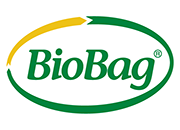Biodegradable and Compostable
Biodegradable and compostable are terms used when describing organic materials breaking down in a specific environment. Both terms are often used when describing environmentally friendly products. The term biodegradable is very often misused in marketing and advertising of products and materials that are not actually environmentally friendly. This is why BioBag more often uses the term compostable when describing our products. All of BioBag’s products are third-party certified compostable.
Biodegradable
The definition of biodegradable is that a material is capable of undergoing biological anaerobic or aerobic degradation leading to the production of CO2, H2O, methane, biomass, and mineral salts, depending on the environmental conditions of the process. An important role in biodegradation is played by microorganisms, which are present in the environment and fed mostly by organic waste. However, unlike compostable, the term biodegradable means very little as everything is biodegradable given time. Thus, it is very important to specify the environment where biodegradation is intended to take place.
Compostable
Composting is the process of breaking down organic waste by microbial digestion to create compost. Compost has many beneficial uses including improving and fertilizing soil. To go through a composting process, organic waste requires the right level of heat, water, and oxygen. In a pile of organic waste, there are millions of tiny microbes that consume the waste, transforming the organic materials into compost. In order to claim that a product is fully compostable, the product has to meet all the requirements in the European Norm EN 13432 and/or the US Standard ASTM D6400. Both specifications require that biodegradable/compostable products completely decompose in a composting setting in a specific time frame, leaving no harmful residues behind.
International Standards
In addition to the European Standard EN 13432, some countries have their own norms like the US Standard ASTM D6400, and the Australian norm AS4736 (minimal differences between the norms).
Today, the terms biodegradation, biodegradable materials, compostability etc. are very common, but frequently misused. Consequently, this is a source of misunderstanding. The European Standard EN 13432 “Requirements for packaging recoverable through composting and biodegradation – Test scheme and evaluation criteria for the final acceptance of packaging”, resolves this problem by defining the characteristics that a material must have, in order to be defined as “compostable”, namely that it can be recycled through organic recovery (composting and anaerobic digestion). This standard applies to plastic packaging and lignocellulosic materials. The standard excludes plastic materials not used as packaging, such as plastics used in agriculture or bags for waste collection, which are covered by Standard UNI EN 14995. From a technical perspective it is identical to UNI EN 13432, but it can cover a wider range of applications other than packaging. The technical content of the two standards is identical, meaning that any plastic material that complies with UNI EN 13432 also complies with UNI EN 14995, and vice versa. These standards are the most important technical references for manufacturers of materials, public authorities, composters, certifying bodies and consumers.
According to the European Standard EN 13432, a compostable material must have the following characteristics:
- Biodegradability, which is determined by measuring the actual metabolic conversion of the compostable material into carbon dioxide. This property is quantitatively measured using the standard test method, EN 14046 (which is also published as ISO 14855: biodegradability under controlled composting conditions). The acceptance level is 90%, which must be reached in less than 6 months.
- Disintegrability, that is, the fragmentation and loss of visibility in the final compost (absence of visual contamination). This is measured with a composting test (EN 14045). The test material is degraded, together with organic waste, for 3 months. After this time, the compost is sieved with a 2 mm sieve. The residues of test material with dimensions higher than 2 mm are considered as not having disintegrated. This fraction must be less than 10% of the initial mass.
- Absence of negative effects on the composting process. This is checked with a composting test.
- Low levels of heavy metals (below the predefined maximum values), and absence of negative effects on the quality of the compost (e.g. reduction of the agronomic value and presence of eco-toxicological effects on the growth of plants). A plant growth test (OECD test 208, modified) is carried out on compost samples where the degradation of the test material has taken place. There must be no difference from control compost. Other chemical-physical parameters that must not be different from those of the control compost after the degradation are the pH, salinity, volatile solids, N, P, Mg, K.
- Each of these requirements must be met simultaneously for a material to be defined as compostable. For example, a biodegradable material is not necessarily compostable because it must also break up during one composting cycle. On the other hand, a material that breaks up, over one composting cycle, into microscopic pieces that are not totally biodegradable, is not compostable.
Standard EN 13432 is a harmonised technical standard, meaning it has been published in the Official Gazette of the European Community and must therefore be implemented in Europe by national standardisation bodies. In addition, materials that comply with this standard are presumed to comply with European Directive 94/62/EC on packaging and packaging waste.





